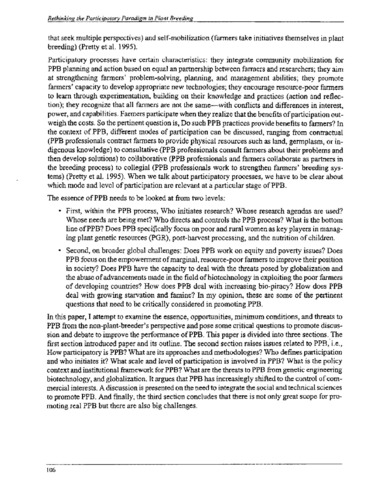Recent progress in cassava varietal improvement in the Philippines
In recent years cassava has become an important raw material for various domestic needs (food, feed, alcohol and high fructose sugar). To cope with high demand for cassava roots the breeding and selection program has been intensified to identify varieties that are high yielding and having high starch and dry matter contents. The continuous introduction of improved cassava populations from the Thai-CIAT program and from CIAT/Colombia contributed to the identification of good varieties, and, consequently, the establishment of cassava genepools having a wide genetic base. This has led to the establishment of a breeding program using the best parents of local and foreign sources.
Progress in selection for the last three years was observed but was not phenomenal. In fact, from the regional trials jointly conducted by PRCRTC and its cooperating stations, two new varieties of cassava from CIAT/Colombia selected by the University of the Philippines at Los Banos, were released by the National Seed Industry Council. These are CM34 19-2A as PSB CV- 11 and SM972-20 as PSB CV-12. Both are intended for food and feed because of their low levels of HCN.
Using the popular variety Lakan as check for the selection and evaluation among introduced materials from CIAT/Colombia and Thailand, gradual progress is made in yield and dry matter content. Superior varieties have been identified but are still in the pipeline for further testing.
Varietal dissemination of new varieties has been intensified through on-farm trials and demonstration farms in strategic areas where farmers have the opportunity to observe and select. The involvement of the private sector, specifically the San Miguel Corporation, in the creation of high demand for cassava has paved the way for the rapid increase of production in terms of area and varietal dissemination.
For the last two years the Agribusiness Division of San Miguel Corporation has supported 3,000 ha of cassava in Mindanao. Support given is in terms of planting material, land preparation and fertilizer input. All produce will go to San Miguel with a price profitable to the farmers. The projected cassava area needed to meet the needs of San Miguel Corporation is 55,000 ha. To this effect, variety trials are conducted in farmers. fields using recommended varieties (Rayong 60, Rayong 90, Rayong 5, KU-50 and the VC series) in Mindanao. Furthermore, rapid propagation is planned to back-up the need for more planting material.
Aside from the San Miguel Corporation, starch millers throughout the country continue to expand their production area due to the high demand for starch. High HCN varieties are preferable. VC-5, which is high in HCN, is now planted in more than 3,000 ha in Lanao, while more than 1,000 ha of Lakan are planted in Negros Occidental to support Unistarch. Further selection will focus on identification of superior varieties with high starch content and high yield while having low to high levels of HCN.

